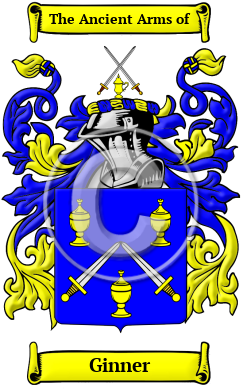| ![Show Contents]() Ginner History, Family Crest & Coats of Arms Ginner History, Family Crest & Coats of Arms
Etymology of GinnerWhat does the name Ginner mean? The distinguished surname Ginner was first brought to England in the wake of the Norman Conquest of 1066. The name is derived from the Old French "engigneor" or "enginior," meaning "engineer, maker of military machines." During the 12th century, the term "ingeniator" was used to refer to men who worked as both master-mason and architect. 1 The Joyner variant is "an occupative term came into use somewhat later than carpenter." 2 Waldinus Ingeniator (the engineer) occurs in the Domesday Book of Lincolnshire, as a tenant in chief. 3 Early Origins of the Ginner familyThe surname Ginner was first found in Yorkshire during the 12th century. The first recorded bearer of the name was Ailnoth Ingeniator, a military architect who served as surveyor of royal buildings in 1157. He supervised building operations at Windsor between 1166 and 1173, repaired Westminster Abbey after a fire, and headed the destruction of Framlingham and Walton Castles. 4 Other early bearers of the name include Richard Lenginnur, recorded in the Pipe Rolls of Yorkshire between 1191 and 1197, and William Enginur, who was living in Suffolk in 1202. The Hundredorum Rolls of 1273 list Hugh le Ginnur in Oxfordshire and William le Engynur in Suffolk. 2 William Joynier was Lord Mayor of London in 1239. Records in Scotland are very scarce, but here the name is a "variant of Jenner, influenced by the occupative name 'joiner.' Alexander Joyner in Aberdeen, 1798. As far as the Jenner variant is concerned, the first on record here was Anneys la Gynnere del counte de Berewyk who rendered homage to King Edward I of England in 1296. "In 1392 there is reference to the tenement of Alan Gynowr in Edinburgh, Patrik Genour held lands in Inverness in 1452, umquhile Thomas Genor is referred to in 1492, Donald Jenor, 'legislator,' is mentioned in 1499, William Genour was tenant of the Casteltoun, Ardmanoch in 1504." 5 Early History of the Ginner familyThis web page shows only a small excerpt of our Ginner research. Another 175 words (12 lines of text) covering the years 1086, 1296, 1452, 1564, 1622, 1631, 1637, 1656, 1662, 1668, 1676, 1678, 1687, 1691, 1706, 1707 and 1750 are included under the topic Early Ginner History in all our PDF Extended History products and printed products wherever possible. Ginner Spelling VariationsDuring the era when a person's name, tribe and posterity was one of his most important possessions, many different spellings were found in the archives examined. Ginner occurred in many references, and spelling variations of the name found included Jenner, Joyner, Joiner, Junor, Junior, Genner, Ginner, Genower and many more. Early Notables of the Ginner familyDavid Jenner (died 1691), an English clergyman and controversialist, educated at Trinity College, Cambridge. "Afterwards he became a fellow of Sidney Sussex College, and took the degree of M.A. by royal mandate in 1662, and that of B.D., also by royal mandate, in 1668. He was installed in the prebend of Netherbury in the cathedral church of Salisbury 28 June 1676, and was instituted on 15 Oct. 1678 to the rectory of Great Warley, Essex, which he resigned in or about October 1687. He was likewise chaplain to the king. He died in 1691." 6
Thomas Jenner (fl. 1631-1656), was an English...
Another 137 words (10 lines of text) are included under the topic Early Ginner Notables in all our PDF Extended History products and printed products wherever possible.
| Ginner migration to the United States | + |
Gradually becoming disenchanted with life in Ireland many of these uprooted families sailed aboard the armada of sailing ships known as the "White Sails" which plied the stormy Atlantic. These overcrowded ships often arrived with only 60 to 70% of their original passenger list, many dying of illness and the elements, were buried at sea. In North America, early immigrants bearing the family name Ginner, or a spelling variation of the surname include:
Ginner Settlers in United States in the 19th Century- Henry William Ginner, aged 30, who landed in Missouri in 1849 7
- Hanks, Patricia and Flavia Hodges, A Dictionary of Surnames. Oxford: Oxford University Press, 1988. Print. (ISBN 0-19-211592-8)
- Bardsley, C.W, A Dictionary of English and Welsh Surnames: With Special American Instances. Wiltshire: Heraldry Today, 1901. Print. (ISBN 0-900455-44-6)
- Lower, Mark Anthony, Patronymica Britannica, A Dictionary of Family Names of the United Kingdom. London: John Russel Smith, 1860. Print.
- Reaney, P.H and R.M. Wilson, A Dictionary of English Surnames. London: Routledge, 1991. Print. (ISBN 0-415-05737-X)
- Black, George F., The Surnames of Scotland Their Origin, Meaning and History. New York: New York Public Library, 1946. Print. (ISBN 0-87104-172-3)
- Smith, George (ed), Dictionary of National Biography. London: Smith, Elder & Co., 1885-1900. Print
- Filby, P. William, Meyer, Mary K., Passenger and immigration lists index : a guide to published arrival records of about 500,000 passengers who came to the United States and Canada in the seventeenth, eighteenth, and nineteenth centuries. 1982-1985 Cumulated Supplements in Four Volumes Detroit, Mich. : Gale Research Co., 1985, Print (ISBN 0-8103-1795-8)
 |

